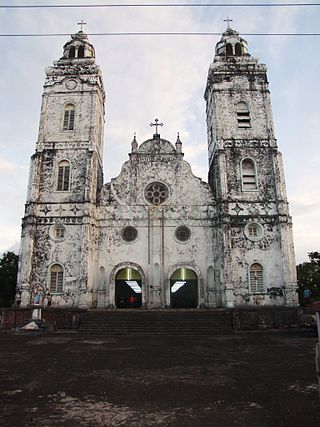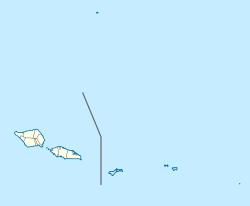
Samoa, officially the Independent State of Samoa and known until 1997 as Western Samoa, is an island country in Polynesia, consisting of two main islands ; two smaller, inhabited islands ; and several smaller, uninhabited islands, including the Aleipata Islands. Samoa is located 64 km west of American Samoa, 889 km northeast of Tonga, 1,152 km northeast of Fiji, 483 km east of Wallis and Futuna, 1,151 km southeast of Tuvalu, 519 km south of Tokelau, 4,190 km southwest of Hawaii, and 610 km northwest of Niue. The capital and largest city is Apia. The Lapita people discovered and settled the Samoan Islands around 3,500 years ago. They developed a Samoan language and Samoan cultural identity.

The Samoan Islands were first settled some 3,500 years ago as part of the Austronesian expansion. Both Samoa's early history and its more recent history are strongly connected to the histories of Tonga and Fiji, nearby islands with which Samoa has long had genealogical links as well as shared cultural traditions.

Savaiʻi is the largest and highest island both in Samoa and in the Samoan Islands chain. The island is also the sixth largest in Polynesia, behind the three main islands of New Zealand and the Hawaiian Islands of Hawaii and Maui. While it is larger than the second main island, Upolu, it is significantly less populated.

Niutao is a reef island in the northern part of Tuvalu. It is one of the nine districts (islands) of Tuvalu. It is also one of the three districts that consist of only one island — not counting the three islets inside the closed lagoon. Niutao has a population of 582.

Vaisigano is a political district at the western tip of Savai'i island in Samoa. The capital of the district is Asau.
Matatumua Maimoana (1935–2012), also known as Matatumua Maimoaga Vermeulen, was a matai, politician, Nurse and Environmentalist of Samoa. Her chief title, Matatumua, was an orator's title from the village of Faleasiu. She was a former member of parliament in Samoa and the founder of the Samoa All People's Party (SAPP), becoming the first woman to lead a political party in the country. SAPP allowed people as young as 16, regardless of gender or whether they were matai to be officers in the organisation which included village branches. She was a founding member of the Human Rights Protection Party (HRPP), which has dominated Samoan politics in the last two decades.
Le Susuga Malietoa Talavou Tonumaipeʻa was installed as "King" of Samoa to the western world on August 28, 1879, until his death on November 9, 1880. Since Malietoa Talavou's half brother's death, Malietoa Moli in 1860, ongoing wars due to power and authority struggle between Talavou and Laupepa over the next Malietoa title holder and the gaining of support by the districts of Samoa. Family rivalry existed as did a 30-year age difference drew a wedge between Malietoa Laupepa and Malietoa Talavou. They were known to be longtime rivals over the Malietoa title.
Faleasi'u is one of the largest village settlements on the island of Upolu in Samoa. It is located on the northwestern coast of the island and has a population of 4177.

Malua is a small village on the Samoan island of Upolu. The name originates from the Samoan word "Maluapapa" which is translated 'shelter under the rock'. It is located on the northwestern coast of the island in the electoral constituency of Sagaga Le Falefa which forms part of the larger political district Tuamasaga.
Matautu is the name of different villages in Samoa. Places named Matautu are found on the two largest islands, Upolu and Savaiʻi.

Solosolo is a village on the northeast coast of Upolu island in Samoa. The village is in the political district of Atua and had a population of 1,851 in the 2016 census and 1,835 in the 2021 census. It is one of the prominent settlements in the area with the largest population in its electoral constituency of Anoama'a 2.

Faʻamatai is the indigenous political ('chiefly') system of Samoa, central to the organization of Samoan society. It is the traditional indigenous form of governance in both Samoas, comprising American Samoa and the Independent State of Samoa. The term comprises the prefix faʻa and the word matai.

Safotulafai is a traditional village at the east end of Savai'i island with historical and political significance in Samoa's history. It is the traditional center of the island of Savaii, now became the center of Fa'asaleleaga political district.
Poutasi is a village on the south east coast of Upolu island in Samoa. The population is 395. The village is part of Falealili Electoral Constituency in the larger political district of Atua. Poutasi was extensively damaged by the 2009 Samoa earthquake and tsunami.

Lauaki Namulau'ulu Mamoe was a renowned orator chief and the first leader of the Mau, a resistance movement in Samoa during colonialism. Mamoe was exiled to Saipan in 1909. He died in 1915 as he was taken back to Samoa.

Safotu is a village on the central north coast of Savai'i island in Samoa. Safotu is in the district Gagaifomauga and has a population of 1270. Traditionally, it attained the status of 'Pule,' customary political authority, and has been the main centre of the Gagaifomauga district.

The architecture of Samoa is characterised by openness, with the design mirroring the culture and life of the Samoan people who inhabit the Samoa Islands. Architectural concepts are incorporated into Samoan proverbs, oratory and metaphors, as well as linking to other art forms in Samoa, such as boat building and tattooing. The spaces outside and inside of traditional Samoan architecture are part of cultural form, ceremony and ritual.

Asau is a village situated on the north west coast of Savai'i island in Samoa. It is the capital village of the Vaisigano political district and serves as the main business centre at the west end of the island. The population in 2016 was 1133, a decrease from 1207 in 2011.

Teo Tuvale was a notable Samoan historian who served terms as Chief Justice and Secretary to Government in Samoa during the era of colonialism.
















